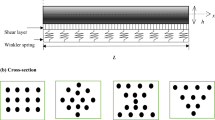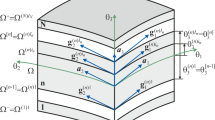Abstract
Delamination of a symmetric circular plate made of viscoelastic composite is studied. It is assumed that the plate has a penny-shaped crack whose edges have a minor axisymmetric imperfection. The lateral surface of the plate is clamped and is compressed by uniform radial normal forces through a rigid body. The studies are made using the exact geometrically nonlinear equations of the theory of viscoelasticity. The delamination criterion is assumed unrestrained growth of the initial imperfection. The Laplace transform and FEM are employed. In particular cases, the results are compared with those for elastic composites
Similar content being viewed by others
REFERENCES
S. D. Akbarov, “On the three-dimensional stability loss problems of elements of structures of viscoelastic composite materials,” Mech. Comp. Mater., 34, No. 6, 537-544 (1998).
S. D. Akbarov and A. N. Guz, Mechanics of Curved Composites, Kluwer Acad. Publ., Dordrecht-Boston-London (2000).
S. E. Benzley, “Representation of singularities with isoparametric finite elements,” Int. J. Num. Meth. Eng., 8, 537-545 (1974).
R. M. Christensen, Mechanics of Composite Materials, Willey, New York (1979).
A. N. Guz, Fundamentals of the Three-Dimensional Theory of Stability of Deformable Bodies, Springer-Verlag, Berlin (1999).
A. N. Guz, “Constructing the three-dimensional theory of stability of deformable bodies,” Int. Appl. Mech., 37, No. 1, 1-37 (2001).
A. N. Guz and I. A. Guz, “The stability of the interface of two bodies compressed along interface cracks. 1. Exact solutions for the case of unequal roots,” Int. Appl. Mech., 36, No. 4, 482-491 (2000).
A. N. Guz and I. A. Guz, “The stability of the interface of two bodies compressed along interface cracks. 2. Exact solution for the case of equal roots,” Int. Appl. Mech., 36, No. 5, 615-622 (2000).
A. N. Guz and V. M. Nazarenko, “Theory of near-surface delamination of composite materials compressed along a macrocrack,” Mekh. Komp. Mater., 5, 826-833 (1985).
A. N. Guz and V. M. Nazarenko, “Fracture mechanics of materials compressed along cracks (review). Highly elastic materials,” Prikl. Mekh., 25, No. 9, 3-32 (1989).
A. N. Guz and V. M. Nazarenko, “Fracture mechanics of materials compressed along cracks (review). Structural materials,” Prikl. Mekh., 25, No. 10, 3-18 (1989).
N. J. Hoff, “Buckling and stability,” J. Royal Aeronaut. Soc., 58, 1-13 (1954).
L. M. Kachanov, “Fracture of composite materials by delamination,” Mekh. Polim., 5, 918-922 (1976).
Yu. N. Rabotov, Elements of Hereditary Solid Mechanics [in Russian], Nauka, Moscow (1977).
R. A. Schapery, “Approximate methods of transform inversion for viscoelastic stress analyses,” in: Proc. US Nat. Congr. Appl. ASME, 4, 1075-1085 (1966).
O. C. Zienkiewicz and R. L. Taylor, The Finite Element Method. 1. Basic Formulation and Linear Problems, 4th ed., McGraw-Hill, New York (1989).
Author information
Authors and Affiliations
Rights and permissions
About this article
Cite this article
Akbarov, S.D., Rzayev, O.G. On the Delamination of a Viscoelastic Composite Circular Plate. International Applied Mechanics 39, 368–374 (2003). https://doi.org/10.1023/A:1024486924343
Issue Date:
DOI: https://doi.org/10.1023/A:1024486924343




